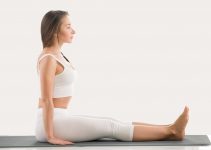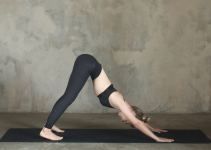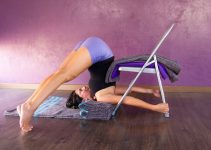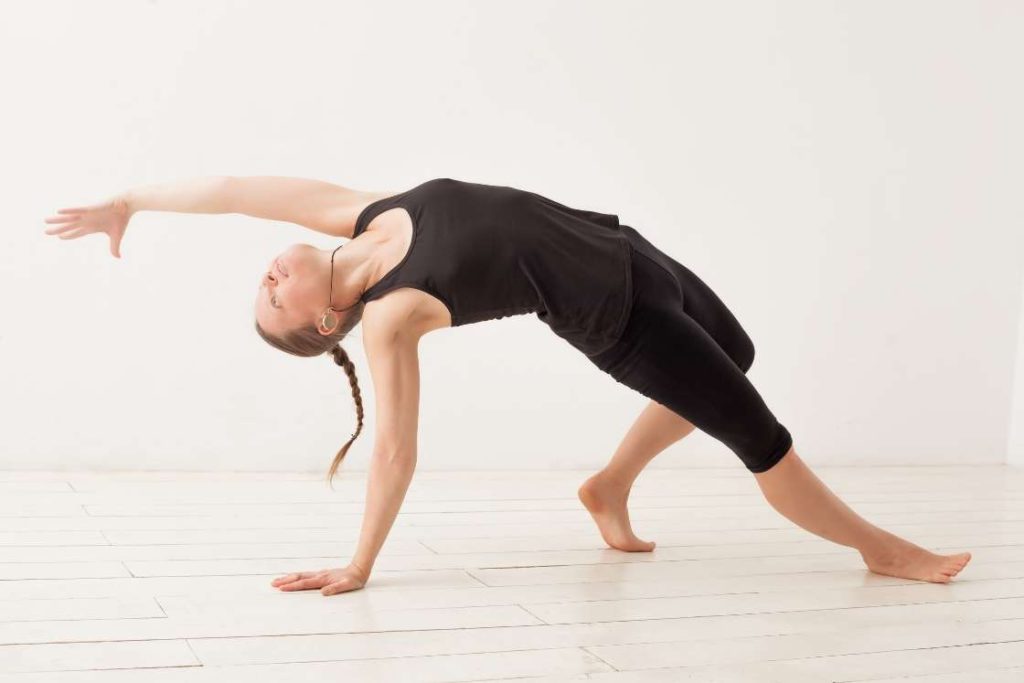
| Sanskrit Pronunciation | Camatkarasana (Cha-mat-kaar-AHS-anah) |
| Meaning | Camatkar = surprise or miracle / asana = pose |
| Pose Type | Prone, back-bend stretch |
| Pose Level | Intermediate |
| Anatomy | Gluteus maximus, triceps, hamstrings, quadriceps |
| Other Names | Flipped Dog Pose, Dancing Dog Pose, |
Camatkarasana is a treat to your body as it generates feelings of joy and ecstasy.
To understand the Camatkarasana meaning, it is important to know that it has been derived from a Sanskrit term, camatkara. It is translated as “surprise” or “miracle.”
It provides energetic benefits to the body physically as well as psychologically. Camatkarasana is a flipping backbend that opens the heart to joy and enables the practitioner to take a leap of faith. This leaves miraculous impacts on the body in all aspects, hence the name.
Yogis better defines camatkarasana as, “the ecstatic unfolding of the enraptured heart“. It opens the heart, mind, and generates guts to take it to the wild side by boosting the confidence. Therefore, also known as the wild thing pose.
Camatkarasana is assumed by flipping the torso upwards from the down-dog pose, hence also referred to as “flip the dog pose“.
Camatkarasana Practice Guide
Go through this practice guide carefully before stepping into the pose to avoid any injury or harm.
Contraindications
- Do not practice it with carpal tunnel syndrome.
- Avoid this posture in case of any injury in the wrists, elbows, back, or rotator cuff muscles.
- People with high blood pressure or any heart ailments must skip this practice.
- It is not a good idea to perform this pose with a heavy head.
Preparatory Poses
Prepare the body for this unusual dynamic backbend with the following poses. They will enhance the balancing ability and strengthen the shoulders, arms, back, and hips.
- Downward-Facing Dog (Adho Mukha Svanasana)
- Bow Pose (Dhanurasana)
- Plank Pose (Phalakasana)
- Upward Plank Pose (Purvottanasana)
- Side Plank Pose (Vasishthasana)
- Dance Pose (Natarajasana)
- Fish Pose (Matsyasana)
- Camel Pose (Ustrasana)
- Extended Side Angle Pose Variation Hand In Front (Utthita Parsvakonasana)
Camatkarasana Instructions
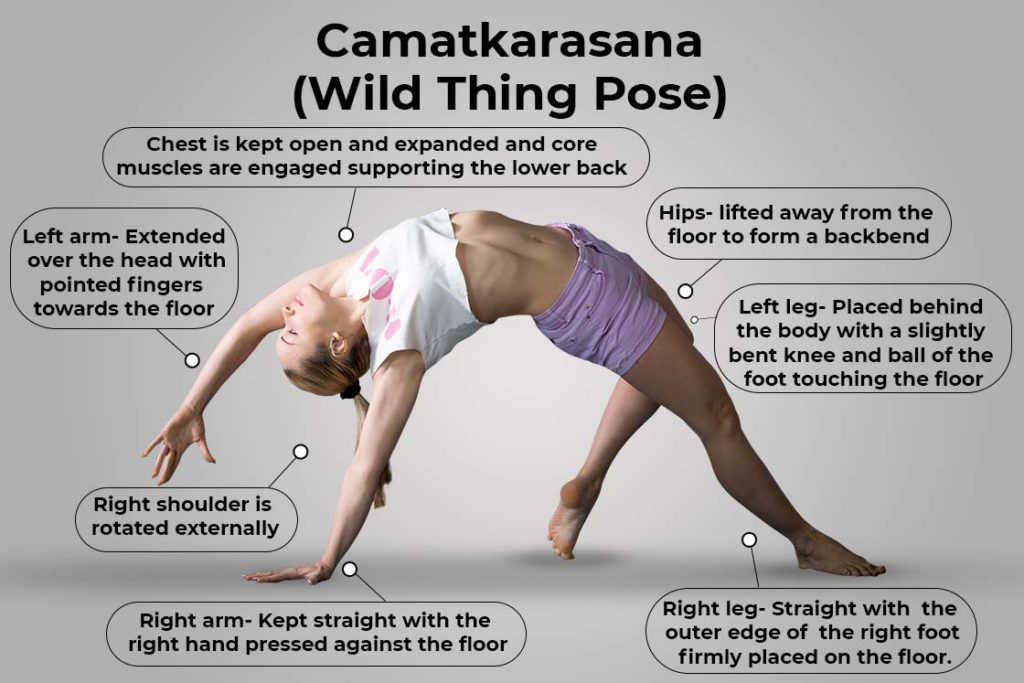
- From the down-dog pose stack your shoulders above your wrists to come to a plank.
- Place your right hand slightly forward of your shoulder and roll onto the outer edge of your right foot.
- Now, step your left foot behind you with a bent knee rotating the torso, meanwhile keep the right leg straight.
- Press the ball of your left foot and the outer edge of the right foot on the floor to lift the hips away from the floor.
- Throw your head and neck backward.
- Lift your left side body extending your left arm over your head to come into a backbend.
- Hold the pose keeping the left fingertips extended towards the floor for 5-10 breaths.
- To release, raise the left arm and pivot on your right foot to come into the down dog. Repeat on the other side.
Follow-up Poses
- Child’s Pose (Balasana)
- Downward-Facing Dog Pose (Adho Mukha Svanasana)
Precautions
- It is very important to keep the alignment precise while performing this backbend to avoid any injury.
- Ensure that you don’t have any balancing issues before trying camatkarasana.
Variations
1. Camatkarasana Grabbing Foot
As the name suggests, in this variation the freely extended hand is used to hold the ankle of the corresponding foot. The neck muscles are kept relaxed and the chest is expanded fully.
2. Camatkarasana Knee-to-Floor
This variation starts with coming to all fours. Then lift your left hand and then straightening the left knee keep the left foot on the floor. However, the right knee and right palm are placed on the floor.
From here, expanding the chest and core muscles extend the left arm over the head to bring the body into a comfortable and approachable backbend.
3. Camatkarasana with One Leg
Practice camatkarasana, bend the right leg firming the foot to the floor. Lift the left foot off the floor pointing the bent left knee to the ceiling followed by cupping your left knee with your left hand.
Now, straighten the left leg and draw the left hand to grab the left big toe with the thumb, index, and middle fingers. Pull the left leg out squaring the hips and shoulders.
4. Camatkarasana Foot to the Head
This is a fusion of the first and third variations mentioned above. After assuming camatkarasana, lift the left foot off the floor bending the knee, and grab the left foot with the freely extended left hand. Further, pull the left foot towards the head similar to Natarajasana.
Camatkarasana Benefits
1. Improves spinal flexibility
It is a back-bending posture that is achieved by opening the chest and shoulders. This is further enhanced by stretching the neck and back muscles which strengthens the upper back. It eventually makes the spine more flexible.
2. Strengthens the arms and legs
Camatkarasana is practiced by extending one arm free and contracting the muscles of the balancing arm. The leg muscles are also stretched while lifting and turning the torso into a backbend. These movements improve the arm and leg strength and flexibility.
3. Builds core strength
While twisting the body from down dog to backbend and expanding the front of the torso the core muscles are actively engaged. The abdominal muscles are stretched and strengthens the core.
4. Enhances lung capacity
This backbend is an excellent chest opener. It stretches and expands the lungs, rib cage, shoulders, and upper abdomen. Also, while balancing the body in camatkarasana the intercostal muscles serve as support. With this, the breathing improves and the diaphragm is also used efficiently.
5. Helps in better digestion
The abdominal muscles are vigorously stretched while flipping into the backbend. The stretch is further enhanced by balancing on one hand and extending the other. Therefore, the digestive organs are stimulated and function efficiently to improve digestion.
6. Facilitates improved blood circulation
Since the heart lies above the head that is body experiences inversion. Also, the chest expands and the pose acts as a gentle workout for the heart. Thus camatkarasana is an effective pose to improve blood circulation.
7. Stimulates the energy chakra
While performing this backbend the neck muscles, heart, lower abdomen undergo intense stretching. This action creates a stimulating effect on the Anahata (heart), Vishuddha (throat), and Svadhisthana (Sacral) chakra.
This results in providing several energetic benefits to the practitioner. It develops feelings of self-love and self-acceptance. It boosts confidence, fearlessness, and helps in developing better communication skills which help in self-expression.
8. Psychological benefits
Camatakarasana is a posture that requires patience, balance, and strength. Therefore, helps in improving mind-body coordination and enhances concentration power.
Along with this, the inversion helps the brain to receive a fresh supply of oxygenated blood. Hence it is used as a therapeutic pose for curing anxiety, stress, depression, and other psychological issues.
Conclusion
Flip your body into the camatakarasana and enjoy the pose with the depth to explore the wild side within.
This pose is a great start to expand your potential and clear all the mental blocks. Get the fulfilling effects following this practice guide especially prepared for you to embrace a better version of yourself.
